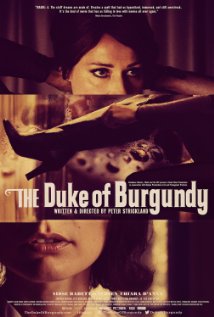
THE DUKE OF BURGUNDY
UK, 2014, 104 minutes, Colour.
Sidse Babett Knudsen, Chiara D'Anna, Monica Swinn, Fatma Mohamed.
Directed by Peter Strickland.
The Duke of Burgundy is one of many moths and butterflies in this film, and one of the few male characters – the other males being moths and butterflies. This film is strictly and narrowly set in a woman’s world.
The director of the film is British, Peter Strickland (Katalin Varga, The Berberian Studio), while the film was produced and made in Hungary with an international continental cast, led by Sidse Babett Knudsen star of the Danish television and internationally popular series, Borgen.
One of the central characters in this rather hothouse, art house drama is an entomologist, played by Sidse Babett Knudsen, with a huge collection of moths and butterflies, doing research, presenting papers at the local meeting house, other presenters being women, the audience only women.
The writer-director clearly wants us to focus on the imagery of the moths, moths drawn to the flame, moths destroying themselves, the delicacy and strength of moths. The entomologist, Cynthia, is frequently seen using a microscope. And that is also an image for the film and the filmmaking. Strickland applies his cinema lens, something of a microscope, to observing the two characters, their interactions, strengths and weaknesses, dominator and dominated. This is a lesbian story.
The advertising of the film refers to a critic saying that it is 50 Shades of Grey for the thinking person! And that is not entirely wrong. While the focus on the two characters is intense and the theme certainly is sado-masochistic domination, it does not have the broader social scope of E. L. James’ story and the sadomasochism for the to multiplex audience.
The film opens with Evelyn sitting in nature, the trees, a babbling book, then going to a house, waiting for the mistress of the house to answer the door, which she very definitely is, and the maid, put upon by the mistress, spurned, criticised, made to do menial work and be accountable. Actually, while there are glimpses of trees, the film rarely goes outside the house except into the yard with the prying neighbour, and into the rather empty streets of the town and the meeting house.
When some of the scenes are repeated, the audience realises that all is not that this seems to indicate. Cynthia is the intellectual, the superior personality, bossing Evelyn around. Soon the audience sees that, in fact, Evelyn is the stronger of the two and that Cynthia is role-playing. Sado-masochistic complication comes when a local cabinetmaker, and a strong feminine character, comes to prepare a gift for Evelyn’s birthday and suggests a casket in which the partner can be locked away for long periods – which happens.
If the audience is drawn in by the situation, characters, the themes, they would be very patient as the film takes its slow pace to unfold its story and character revelation. Otherwise, many audiences will find it on the tedious and repetitious side (with a distraction, perhaps, that a violent car chase would not go amiss!). This means that the film has been acclaimed by many who admire the cinematography, the performances, the atmosphere, while others may forget it, feel distant and not be absorbed. Which is what cinema does.
1. A hothouse exploration of relationships, in a woman’s world?
2. The work of the director, his interest in women’s issues, his writing a lesbian relationship story, sado-masochism? The issue of the male gaze and the portrayal of the women, the photographing of the women, of the relationship?
3. The locations in Hungary, the lake, the forests, the small town, the absence of cars, travel by bicycle, the house, the interiors, the lecture hall? The musical score?
4. The title, the male, the moth, the range of moths and butterflies, flying, impaled? The irony of the male moths in a women’s world? The role of Cynthia as an entomologist, her studies, office, writings, using a typewriter, lectures, experiments? The other entomologists in the town, the range of lectures and explorations?
5. The metaphor of the moth attracted by the light, for destruction? The metaphor of the microscope, the filmmaker and his microscopic study of the women and their relationship?
6. The lesbian theme, other films with these themes? Sadomasochism? Domination?
7. The opening, the introduction to Evelyn, the old style dress and cape, sitting in nature, coming to the house, Cynthia and her response, Evelyn as the maid, her menial work, the criticisms by Cynthia? Her continuing to work in the house?
8. Cynthia, the mistress of the house, the scientist, her curt manner with Evelyn, reading and ignoring her, making demands, the washing, the neglected underwear, Evelyn and her submissive behaviour, doing the washing, hanging it to dry?
9. Lorna, the neighbour, putting out the washing, observing, the two women and their reactions towards her?
10. The women in the town, the compere at the lecture, the women in the audience?
11. The role-playing, Evelyn and her dominance, setting up Cynthia for role-plays, controlling? Cynthia and her response? The audience watching, seeing some of the situations repeated, looked at from a different perspective?
12. The visit of the woman and her carpentry? The genteel manner, discussing human toilets, discussing caskets for being interned? Evelyn’s birthday? The commissioning of the casket, its arrival, its use, Evelyn being put in, time and darkness, wanting to come out?
13. The changing perspectives on the relationship, Evelyn and her manner, her seeming subservience and work, Cynthia and her seeming control but actual subservience?
14. The portrait of the love, the love making, the sensuality? The violence, sadism and massacres?
15. Hothouse movie, slow-moving, style and critical appreciation, difficult film for a general public?